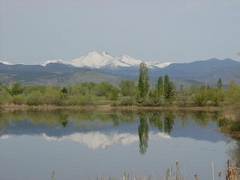 Sterling Colorado, the Queen City of the Plains, is about 140 miles northeast of Longmont and is the seat of Logan County. You may remember Sterling's renovated Carnegie library, and they have one of the finest courthouses around. In 1890, beets were first commercially grown in Logan County making it the first Colorado location away from the Agricultural College (CSU) to do so. Factory talk in Sterling began the same year when expenses were approved for a committee to visit an existing beet factory in Grand Island, Nebraska with the hope of getting a similar factory built in Sterling. It would be fifteen more years until that would happen.
Sterling Colorado, the Queen City of the Plains, is about 140 miles northeast of Longmont and is the seat of Logan County. You may remember Sterling's renovated Carnegie library, and they have one of the finest courthouses around. In 1890, beets were first commercially grown in Logan County making it the first Colorado location away from the Agricultural College (CSU) to do so. Factory talk in Sterling began the same year when expenses were approved for a committee to visit an existing beet factory in Grand Island, Nebraska with the hope of getting a similar factory built in Sterling. It would be fifteen more years until that would happen.In the meantime, beets continued to be grown very successfully in Logan County, usually destined for the Eaton or Greeley factories for processing. In 1905, contracts for 4,000 acres of beets were secured from local farmers, which was enough to attract capital to build a beet factory in Sterling. The Sterling Sugar Company broke ground on a factory on April 5, 1905 and a mere seven months later, on November 7, their beet processing campaign began. A two-day celebration was held in town, including visits by dignitaries and a barbecue. The factory was far from being complete at this time, however, and the first campaign was problematic and inefficient, to say the least. Some beets had to be sent to Longmont. In addition to beets from the local growers, beets were also brought to Sterling from the Morgan County to the west, and Sedgewick County (Julesberg) to the east. Like all of the other factories, the Great Western Sugar Company acquired the factory soon after it was built.
Twenty years later, in 1924, the Sterling factory had 26,000 acres under contract, from Merino to Julesburg, and had processed an amazing 266,489 tons of beets that year.
The Sterling Factory, around 1919, built in the southern part of town:

The Sterling factory was closed in 1985, having finished its final campaign in February of that year. It operated for 80 years (1905-1985).
Today, the idle Sterling sugar factory still stands, including the water tower:



The factory administration building:

And what looks like an on-site residence, perhaps modified once or twice:

A dinky steam engine used for years in the Sterling factory is on display under the main Sterling water tower, just across the tracks from the factory. A great article on dinkies by Jeff Terry says that this engine was built in 1928, in Maple Grove, Ohio and purchased by Great Western in 1931. We'll see at least two more dinkies in future sugar factory visits. The Longmont factory dinky is apparently in pieces, in the Kansas City area.



A newspaper article on display at the nice Overland Trail Museum in Sterling shows the top sugar beet growers of 1971.

Continuing series on the northeastern Colorado beet sugar factories:

 One citizen's view of Longmont, Colorado, USA.
One citizen's view of Longmont, Colorado, USA.

1 comment:
So is this factory located on a main line, or is the rail a spur? The original brick building has an interesting aestethic -- you'd think there'd be potential for restoring it as either retail or mixed use, then connecting it to other areas via the line.
Or letting it sag into obscurity, take your pick.
I like these posts, they give me a new appreciation for sugar beets. I wonder if there would be a way to tell a difference in sugar made from cane from sugar made from beets. I wonder if there's a nutritional/health difference.
Of course, I wonder lots of things! Thanks for all the research.
Post a Comment